What Is the Meaning of Twenty One Pilots’ Iconic Symbols?
Twenty One Pilots' symbols encompass profound themes such as identity, mental health, and personal struggles. The Blurryface Era utilizes a red and black palette to represent internal conflict and emotional intensity, with Blurryface personifying insecurities.
The Skeleton Clique symbol underscores community and resilience. The Trench Era introduces the fictional city of Dema, highlighting mental struggles through the imagery of Bishops and Banditos, with yellow tape symbolizing hope and resistance.
These elements culminate in a rich and engaging narrative, offering deeper insights into the band's thematic complexities if explored further.

Key Takeaways
- The red and black palette symbolizes internal conflict, with red representing passion and struggle, and black symbolizing darkness and anxiety.
- Blurryface personifies insecurities, exploring themes of identity struggles and emotional connection with the audience.
- The Skeleton Clique symbol signifies mortality, personal struggle, and unites the fan community.
- Yellow tape represents hope, resilience, and mental health awareness within the Trench narrative.
- Dema and the Bishops symbolize oppressive forces and inner demons, with Banditos embodying resistance and the fight for freedom.
The Blurryface Era
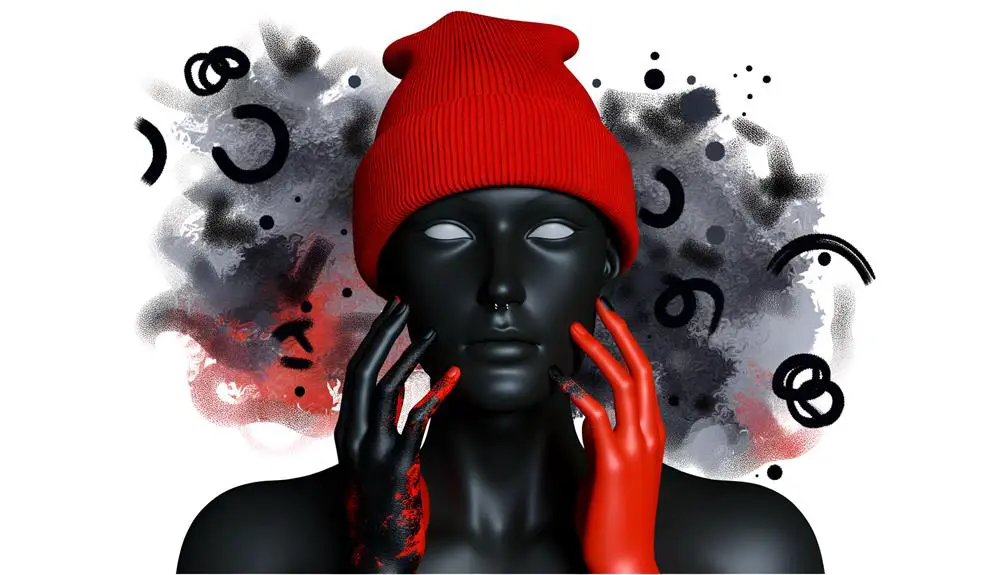
The Blurryface Era represents a pivotal moment in Twenty One Pilots' career, marked by a thematic exploration of insecurity and identity struggle through both their music and symbolic imagery.
This era, encapsulated in the 2015 album 'Blurryface,' delves into the internal battles faced by the band's frontman, Tyler Joseph. By personifying his insecurities as the character 'Blurryface,' Joseph provides a relatable narrative for fans grappling with similar issues.
The album's lyrics and soundscapes blend genres, creating an eclectic yet cohesive experience. Symbolically, the use of dark, haunting imagery underscores the themes of anxiety and self-doubt.
This era not only solidified the band's distinctive style but also resonated deeply with a global audience, fostering a strong emotional connection.
The Red and Black Palette
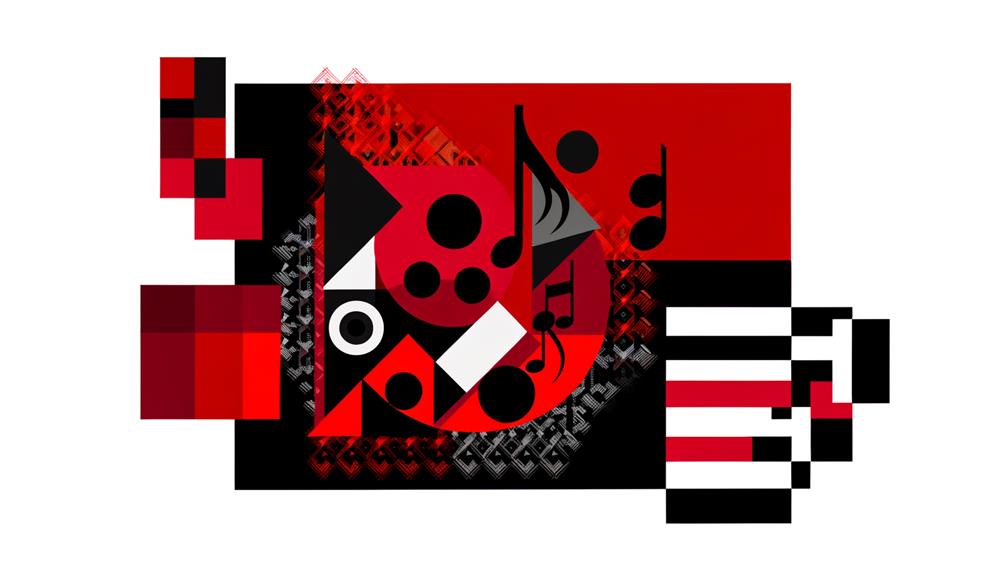
Intricately woven into the visual identity of the Blurryface era, the red and black palette serves as a powerful symbol of the internal conflict and emotional intensity expressed in Twenty One Pilots' music. This stark color combination reflects the duality of the human psyche, oscillating between dark, depressive states and bursts of passionate emotion.
The choice of colors is not arbitrary; rather, it is a deliberate design to evoke specific psychological responses.
Red: Symbolizes passion, intensity, and the struggle against inner demons.
Black: Represents darkness, anxiety, and the overwhelming sense of dread.
Contrast: The interplay between red and black highlights the tension between hope and despair, central themes in their lyrics.
This palette is a visual manifestation of the band's thematic complexity.
The Skeleton Clique Symbol
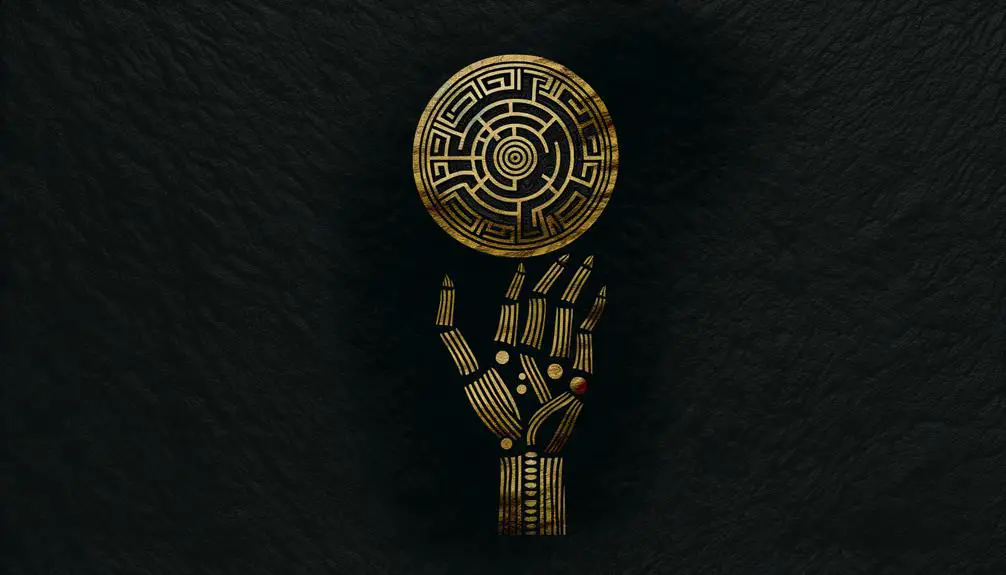
Building upon the evocative red and black palette, the Skeleton Clique symbol further encapsulates the band's ethos and connection with their dedicated fanbase.
The symbol, often depicting skeletal figures, resonates deeply with themes of mortality, personal struggle, and resilience—central tenets of Twenty One Pilots' music. It serves as a visual representation of the community's solidarity, portraying a sense of unity among fans who identify with the band's message.
This symbol not only reinforces the intimate bond between the band and their followers but also fosters a collective identity. The use of skeletal imagery underscores the raw and unfiltered nature of the emotional battles discussed in their lyrics, making it a powerful emblem within the Twenty One Pilots' narrative.
The Trench Era

The Trench era of Twenty One Pilots introduced a complex narrative centered around the fictional city of Dema and its oppressive Bishops, symbolizing internal struggles and societal constraints.
Integral to this storyline are Clancy's cryptic messages, which provide fans with deeper insights into the band's thematic exploration of escape and resistance.
Additionally, the recurrent use of yellow tape weaves a visual motif of hope and resilience throughout the era's imagery and performances.
Dema and Bishops Symbolism
Central to the symbolism in Twenty One Pilots' 'Trench' era is the concept of Dema, a fictional city representing mental struggles, and its oppressive rulers, the Bishops. This narrative serves as a metaphor for the internal battles faced by individuals dealing with mental illness and societal pressures.
The Bishops, as antagonistic figures, symbolize the pervasive and controlling nature of these struggles.
Key symbolic elements include:
- Dema: A walled city symbolizing entrapment and the pervasive nature of mental health issues.
- Bishops: Representing figures of authority and control, embodying the obstacles within one's mind.
- Yellow Tape: A symbol of rebellion and hope, marking the resistance against oppressive forces.
These elements collectively create a powerful allegory for the band's message on mental health.
Clancy's Secret Messages
Amidst the intricate narrative of the 'Trench' era, Clancy's secret messages serve as cryptic insights into the psychological and emotional labyrinth crafted by Twenty One Pilots. These messages, often conveyed through letters and journal entries, provide a fragmented yet profound glimpse into Clancy's struggles within the oppressive confines of Dema.
Yellow Tape Significance
Symbolizing both caution and defiance, yellow tape in the 'Trench' era of Twenty One Pilots serves as a potent visual metaphor for the boundaries and obstacles encountered on the path to mental and emotional liberation. This visual element encapsulates the duality of feeling trapped yet aspiring for freedom.
The significance of yellow tape can be broken down into three key aspects:
- Cautionary Symbolism: It represents the warning signs of mental health struggles, urging awareness and vigilance.
- Defiance and Rebellion: Yellow tape signifies pushing against restrictions, embodying a spirit of resistance.
- Unity and Solidarity: Fans and band members alike use yellow tape to form a collective identity, fostering a sense of community in the face of adversity.
These elements underscore the band's commitment to exploring complex emotional landscapes.
The Yellow Tape
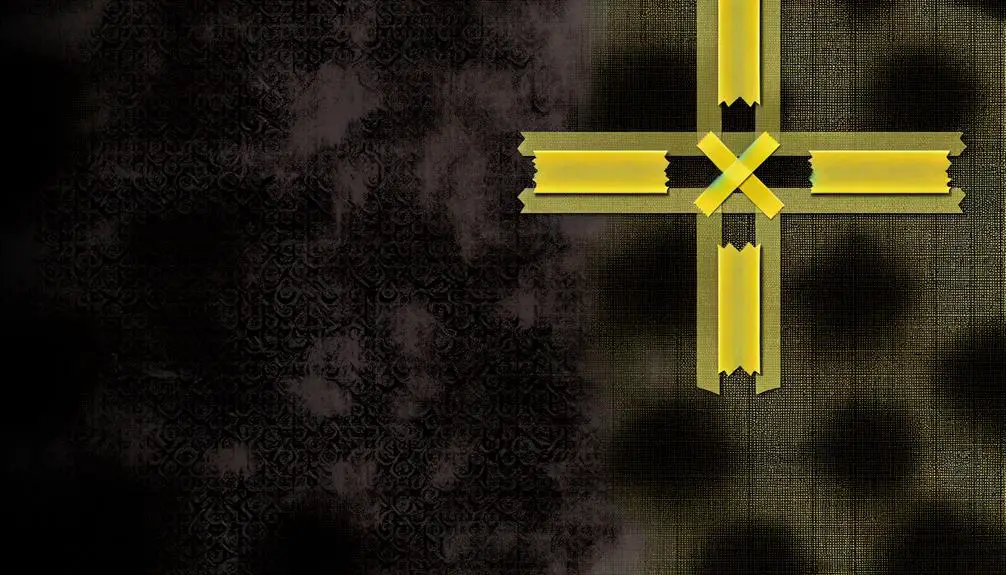
The use of yellow tape in Twenty One Pilots' imagery is a deliberate choice, rich with symbolic meaning that ties into the band's overarching themes of mental health and resistance.
This visual element not only serves as a striking aesthetic feature but also conveys messages of caution and protection, aligning with the narrative established in their 'Trench' era.
Significance of Yellow Tape
Yellow tape has become an iconic element in the visual and thematic lexicon of Twenty One Pilots, symbolizing both caution and unity within their fanbase. This distinctive motif serves multiple purposes:
- Caution and Awareness: The yellow tape often appears in contexts that signal danger or alertness, reinforcing the band's themes of mental health struggles and societal awareness.
- Unity and Identity: Fans, known as the Skeleton Clique, use yellow tape to signify their membership and solidarity with each other and the band.
- Artistic Expression: The yellow tape is a recurring visual element in music videos, concerts, and album artwork, contributing to the band's unique aesthetic and storytelling.
Through these facets, the yellow tape transcends mere decoration, embodying deeper symbolic meanings.
Symbolism in Band Imagery
Twenty One Pilots' use of yellow tape in their imagery serves as a multifaceted symbol that intertwines themes of caution, community, and artistic identity.
The yellow tape, prominently featured in their 'Trench' era, echoes a sense of alertness and self-awareness, urging fans to navigate internal and external struggles with care.
It also fosters a sense of unity among the 'Banditos,' the dedicated fanbase, by visually demarcating a shared space of understanding and solidarity.
This emblematic choice underscores the band's unique artistic identity, blending visual symbolism with their lyrical narratives.
The Vulture Symbolism

Recognized for its stark and unsettling imagery, the vulture in Twenty One Pilots' symbolism serves as a profound metaphor for themes of death, rebirth, and existential struggle. This emblem captures the band's exploration of darker aspects of the human condition and underscores their narrative of resilience and transformation.
The vulture, often seen as ominous, is reinterpreted within their art to depict a cycle of renewal and perseverance.
To elucidate this symbolism, consider these key elements:
- Death and Decay: The vulture represents the inevitable decline, reflecting life's unavoidable hardships.
- Rebirth: It symbolizes renewal, showcasing the potential for new beginnings after enduring struggles.
- Existential Struggle: The vulture embodies the internal battles and the quest for meaning in adversity.
The Bandito Significance
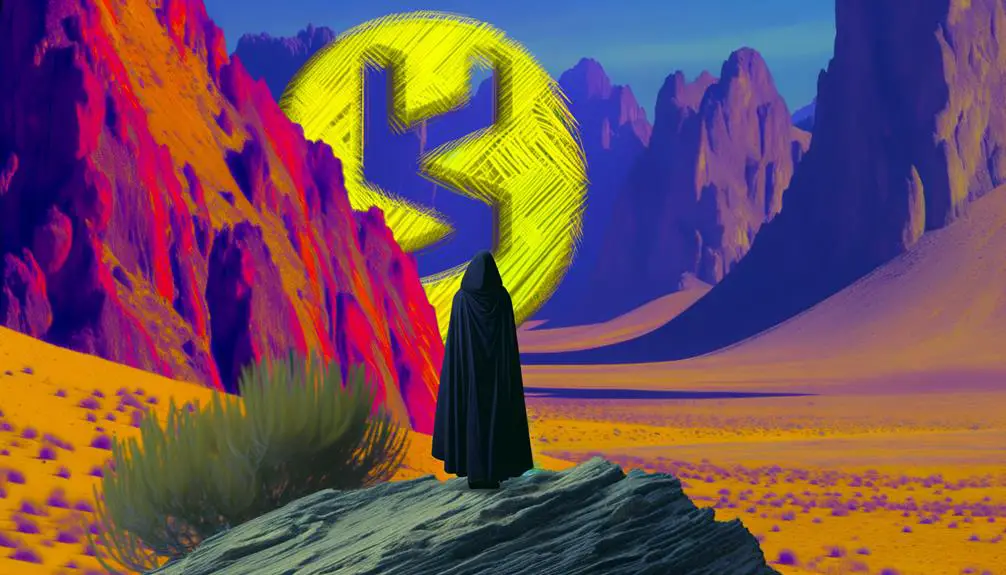
The Bandito significance in Twenty One Pilots' body of work encapsulates a narrative of resistance and self-discovery, serving as a potent symbol of defiance against oppressive forces.
Represented through their album 'Trench,' the Banditos are characters who resist the tyrannical reign of the fictional city Dema. This symbolism is a call to arms for those grappling with internal struggles, advocating for courage and solidarity.
The Bandito figure embodies themes of freedom and resilience, encouraging listeners to challenge their mental confines.
The Dema Concept
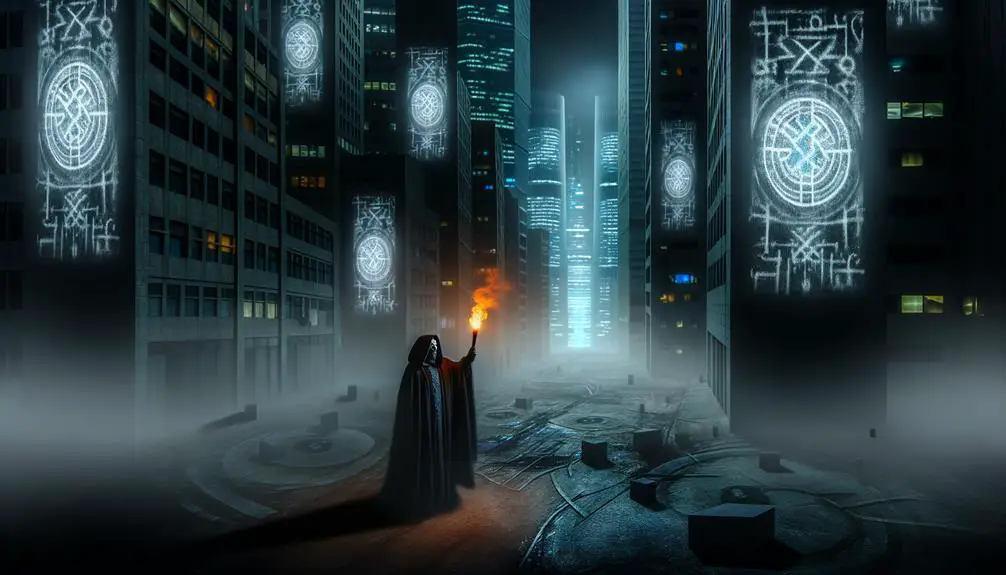
Central to the narrative of resistance and self-discovery is the concept of Dema, a fictional city that symbolizes the oppressive forces Twenty One Pilots urge their listeners to confront. This dystopian metropolis serves as a metaphor for mental and emotional struggles, encapsulating themes of control, isolation, and despair.
Within this elaborate construct, the band introduces key elements that enrich its symbolic framework:
- Bishops: The authoritarian figures representing inner demons and external pressures.
- Trench: The album depicting the journey through and beyond Dema, symbolizing personal growth and escape.
- Banditos: The rebels embodying resilience and the fight for freedom against oppressive forces.
Through Dema, Twenty One Pilots craft a compelling narrative that resonates deeply with their audience's quest for self-liberation.
Conclusion
The symbols associated with Twenty One Pilots serve as a labyrinth through which fans navigate the band's evolving narrative and thematic expressions.
From the dark undertones of Blurryface's red and black palette to the hopeful connotations of Trench's yellow tape, each symbol is a key revealing deeper layers of meaning.
These symbols are not mere embellishments but rather, like a lighthouse in a storm, they guide and resonate with the collective psyche of the Skeleton Clique.





